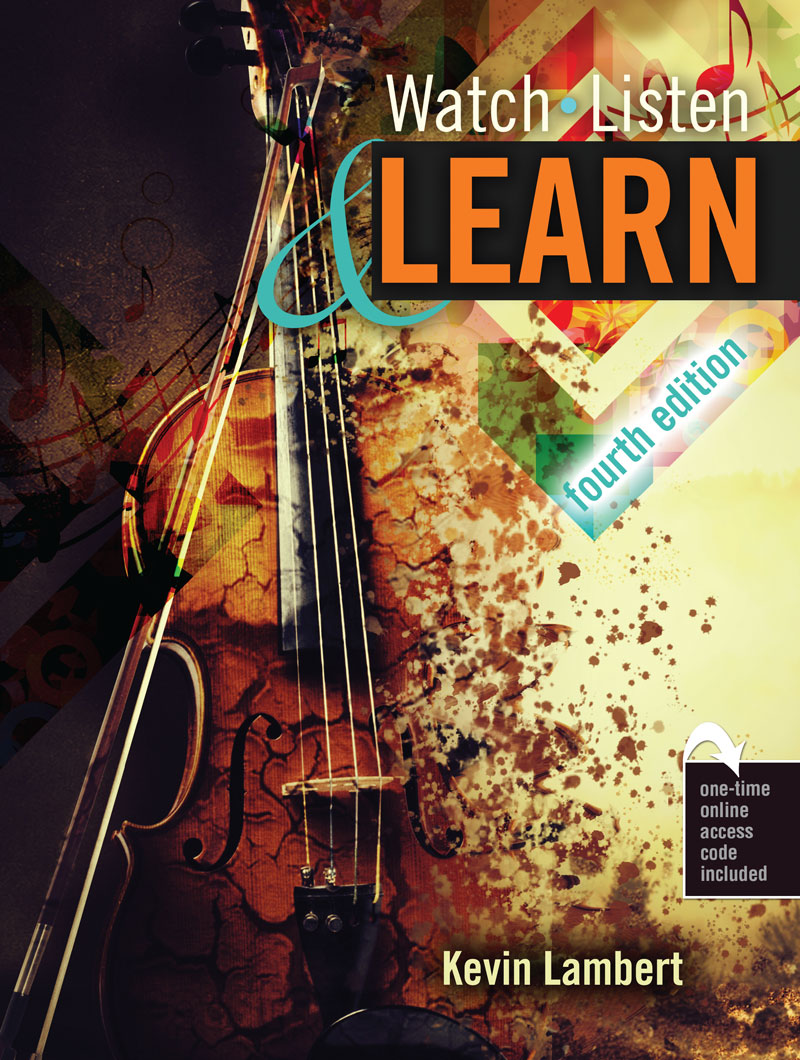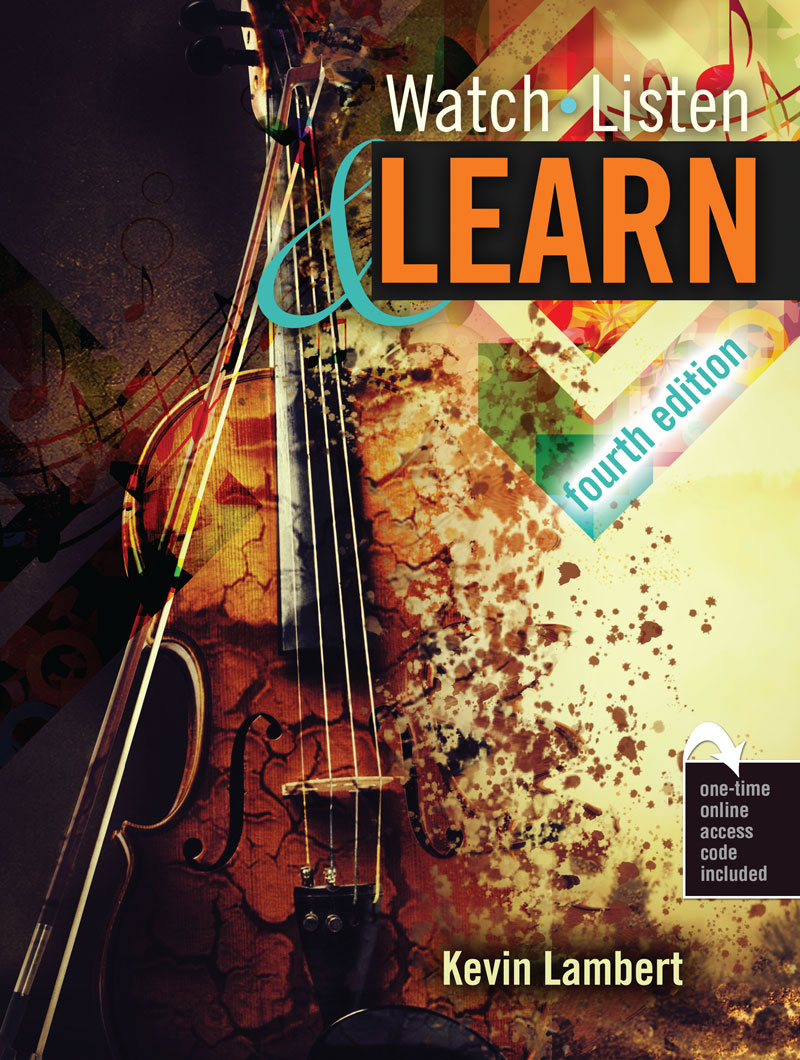Watch, Listen and Learn
Author(s): Kevin Lambert
Edition: 5
Copyright: 2021
CLICK HERE to Purchase Immediate Access to Online Course Content
Watch, Listen, and Learn is a music appreciation text that challenges students to think and engages them with questions to which there are no right or wrong answers, or perhaps no answers at all.
Available as a webtext, Watch, Listen, and Learn features:
- a syllabus.
- study guides for each chapter.
- quizzes and chapter summaries for every chapter.
- unit tests, and a gradebook.
- a comprehensive glossary and flash cards.
Why a webtext instead of an ebook? The answer is that, unlike a hardcopy book or an ebook, everything that is needed for the course is included in the text. As you will see the book has built into it a syllabus, study guides for each chapter, quizzes and chapter summaries for every chapter, unit tests, and a gradebook, as well as a comprehensive glossary and flash cards.
Preface
Chapter 1: What Are We Studying? Western European Art Music
Chapter 2: Elements of Music, part one
Chapter 3: Elements of Music, part two
Chapter 4: Gregorian Chant and Polyphony
Chapter 5: Josquin des Prez (c. 1450–1521) “Ave Maria”
Chapter 6: William Byrd (c. 1540–1623) “Sing Joyfully”
Chapter 7: Johann Sebastian Bach (1685–1750) Fugue in g minor, BWV 578 (Little)
Chapter 8: Antonio Vivaldi (1678–1741) Winter, Movement One
Chapter 9: George Frideric Handel (1685–1759) Messiah, “Hallelujah Chorus”
Chapter 10: Franz Joseph Haydn (1732–1809) String Quartet in C Major, Op. 76, No. 3, Second Movement
Chapter 11: Wolfgang Amadeus Mozart (1756–1791) Symphony No. 40 g Minor, Movement One
Chapter 12: Wolfgang Amadeus Mozart (1756–1791) Le nozze di Figaro, (The Marriage of Figaro) Act IV, Finale
Chapter 13: Ludwig van Beethoven (1770–1827) Symphony No. 5 in C Minor, Op. 67. First Movement
Chapter 14: Franz Schubert (1797–1828) Erlkönig
Chapter 15: Hector Berlioz (1803–1869) Symphonie fantastique, Fourth Movement
Chapter 16: Richard Wagner (1813–1883) Die Walküre (The Valkyrie), Act 3, Scene 3
Chapter 17: Claude Debussy (1862–1918) Prélude à l’après-midi d’un faune Beau Soir Préludes, Book 1 Voiles
Chapter 18: Igor Stravinsky (1882–1971) Le Sacre du printemps, Octet, Threni: id est Lamentationes Jeremiae Prophetae
Chapter 19: Arnold Schoenberg (1874–1951) Atonality: String Quartet No. 2, Movement four Variations for Orchestra, Op. 31
Chapter 20: Charles Ives (1874–1954) Variations on “America” The Unanswered Question “Serenity”
Chapter 21: Aaron Copland (1900–1990) Fanfare for the Common Man Hoedown, from Rodeo “The Promise of Living”, from The Tender Land
Chapter 22: What Is Music?
Glossary
"Dr. Lambert’s discussion of art/music is the best definition and description of “art” I have encountered in any text. The introductions to each historical section provided great insight into the role music plays in culture at large, and in specific cultures. Using internet visuals and music clips really add to the enjoyment, depth and retention of the material. This is truly a work that will educate a broad student population."
-Dr. Steven Sweet
Sierra Vista UMC
CLICK HERE to Purchase Immediate Access to Online Course Content
Watch, Listen, and Learn is a music appreciation text that challenges students to think and engages them with questions to which there are no right or wrong answers, or perhaps no answers at all.
Available as a webtext, Watch, Listen, and Learn features:
- a syllabus.
- study guides for each chapter.
- quizzes and chapter summaries for every chapter.
- unit tests, and a gradebook.
- a comprehensive glossary and flash cards.
Why a webtext instead of an ebook? The answer is that, unlike a hardcopy book or an ebook, everything that is needed for the course is included in the text. As you will see the book has built into it a syllabus, study guides for each chapter, quizzes and chapter summaries for every chapter, unit tests, and a gradebook, as well as a comprehensive glossary and flash cards.
Preface
Chapter 1: What Are We Studying? Western European Art Music
Chapter 2: Elements of Music, part one
Chapter 3: Elements of Music, part two
Chapter 4: Gregorian Chant and Polyphony
Chapter 5: Josquin des Prez (c. 1450–1521) “Ave Maria”
Chapter 6: William Byrd (c. 1540–1623) “Sing Joyfully”
Chapter 7: Johann Sebastian Bach (1685–1750) Fugue in g minor, BWV 578 (Little)
Chapter 8: Antonio Vivaldi (1678–1741) Winter, Movement One
Chapter 9: George Frideric Handel (1685–1759) Messiah, “Hallelujah Chorus”
Chapter 10: Franz Joseph Haydn (1732–1809) String Quartet in C Major, Op. 76, No. 3, Second Movement
Chapter 11: Wolfgang Amadeus Mozart (1756–1791) Symphony No. 40 g Minor, Movement One
Chapter 12: Wolfgang Amadeus Mozart (1756–1791) Le nozze di Figaro, (The Marriage of Figaro) Act IV, Finale
Chapter 13: Ludwig van Beethoven (1770–1827) Symphony No. 5 in C Minor, Op. 67. First Movement
Chapter 14: Franz Schubert (1797–1828) Erlkönig
Chapter 15: Hector Berlioz (1803–1869) Symphonie fantastique, Fourth Movement
Chapter 16: Richard Wagner (1813–1883) Die Walküre (The Valkyrie), Act 3, Scene 3
Chapter 17: Claude Debussy (1862–1918) Prélude à l’après-midi d’un faune Beau Soir Préludes, Book 1 Voiles
Chapter 18: Igor Stravinsky (1882–1971) Le Sacre du printemps, Octet, Threni: id est Lamentationes Jeremiae Prophetae
Chapter 19: Arnold Schoenberg (1874–1951) Atonality: String Quartet No. 2, Movement four Variations for Orchestra, Op. 31
Chapter 20: Charles Ives (1874–1954) Variations on “America” The Unanswered Question “Serenity”
Chapter 21: Aaron Copland (1900–1990) Fanfare for the Common Man Hoedown, from Rodeo “The Promise of Living”, from The Tender Land
Chapter 22: What Is Music?
Glossary
"Dr. Lambert’s discussion of art/music is the best definition and description of “art” I have encountered in any text. The introductions to each historical section provided great insight into the role music plays in culture at large, and in specific cultures. Using internet visuals and music clips really add to the enjoyment, depth and retention of the material. This is truly a work that will educate a broad student population."
-Dr. Steven Sweet
Sierra Vista UMC

